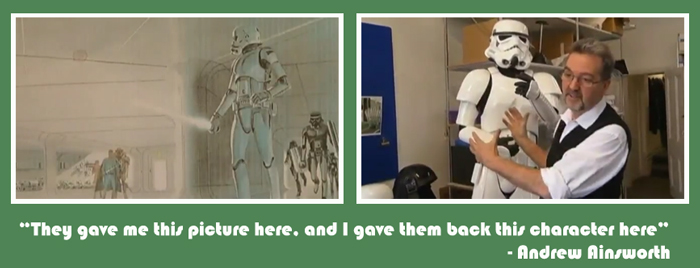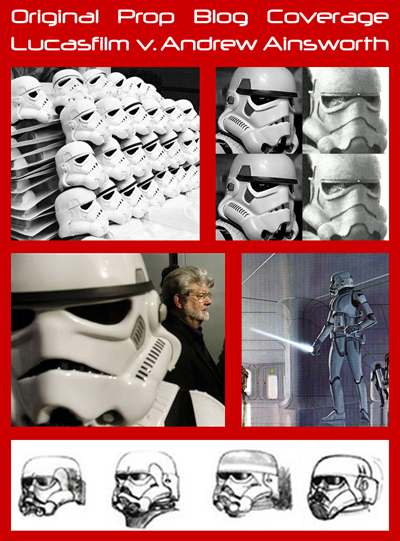Having followed the news reported by the mainstream media following Wednesday’s UK Supreme Court decision, there have been some interesting accounts coming from the Ainsworth camp yesterday and today, including a very simplistic characterization of how the helmet and armor made their way from two to three dimensions (completely leaving out the sculpture contributions by Ms. Liz Moore and Mr. Brian Muir). It will be interesting to see how this saga will continue to play out following the ruling in England.
Two of the more interesting interviews were conducted by National Public Radio (NPR), which can be heard in audio format on their website, which also includes a transcript of the same (see “Stormtrooper Helmet Maker Wins Legal Battle”), with the first audio report also available via the player below:
More from NPR today, in their second related broadcast (see “Designer Wins Right To Sell ‘Star Wars’ Stormtrooper Outfits In The U.K.”):
Yesterday’s Sun (see “Star Wars fan beats dark side”) includes a short video report on the case, which can be found along with the full written article on their site; the video can also be viewed below:
In the interview, Mr. Ainsworth states, “They gave me this picture here, and I gave them back this character here” (images from video copied below):
Interestingly, in various interviews, Mr. Ainsworth equates creating a costume to creating a character.
Additionally, as noted in prior articles, Liz Moore appears to be the artist who was responsible for the original Stormtrooper helmet sculpt while Brian Muir was the first to sculpt armor parts (see “Facebook Hosts Ongoing Public Debate Over Original Sculptor Credit for Star Wars Stormtrooper (Andrew Ainsworth or Liz Moore & Brian Muir)”). The genesis of the three dimensional costume as articulated by Mr. Ainsworth in the interview above does not account for any contributions made by any other artists apart from Ralph McQuarrie, and suggests that he is wholly responsible for the three dimensional interpretation.
Also as noted previously, Mr. Ainsworth also sells unlicensed prop replicas of the Stormtrooper blaster, which is a prop that, as I understand it, he had no role in designing, developing, or creating for the production (see “Shepperton Design Studios Expands Line of “Post Lawsuit” Unlicensed Replica Star Wars Props”), but was created by Roger Christian and others.
As memorialized in earlier reporting on the Original Prop Blog (see “Star Wars “Prototype” Stormtrooper Helmets Update: High Court Ruling Excerpts on LFL v. SDS Case”), Mr. Justice Mann published a fascinating account of one of the earlier legal proceedings, the following in his High Court ruling circa 2008. Below are some excerpts:
15. However, in his evidence he betrayed that he has become somewhat obsessed with the present dispute, and that has led him to put forward versions of events which are reconstructions designed, wittingly or unwittingly, to support his case. His evidence on the events of 1976 changed on a number of occasions. In one sense that is not surprising. Having a detailed recollection of events which took place over 30 years ago is difficult if not impossible, and any purported recollection of detail (and indeed of general patterns) must be viewed with caution.
~
His process of reconstruction, however, betrays a vigour in his approach which puts him more in the role of advocate than witness.
~
This incident, and others, demonstrates that Mr Ainsworth is always looking for a gloss on, or analysis of, evidence which will favour his case.
16. His attempts to play up his part, and to play down Mr Mollo’s part, in the creation of this helmet is a good example of his viewing events through his own Ainsworth-tinted spectacles
17. He also demonstrated a tendency to take credit for things that he was not entitled to in other ways.
~
His statement was therefore untrue, and plainly so. Furthermore, he did not acknowledge that there was anything wrong with his witness statement in this respect. He was either being dishonest about that, or he has a strange subjective view of the truth which calls into question his reliability as a witness in relation to such matters.
19. These particular points are not just general credibility points. They are credibility points going to a central issue in this case, namely the reliability of Mr Ainsworth’s evidence as to his alleged design of some of the relevant material in this case. He has clearly demonstrated that he is prepared to claim more than he is entitled to in other contexts. I have to bear that firmly in mind in considering his claims in relation to the designs in issue in this case.
20. Immediately before he went in the witness box, he produced more evidence in the form of a marked up version of his first witness statement, showing deletions and additions that he wished to make. Some of them were minor; many of them were not. They amounted to very material variations from the first witness statement, for whose truth he had vouched in his statement of truth. That, of itself, might not be a factor going to credibility, but the number and nature of the changes means that in the present case it is.
21. All these factors, and other challenges made to his credibility during the case, make me approach Mr Ainsworth’s evidence with a great deal of caution.
36. I think that this is another example of Mr Ainsworth’s propensity to claim authorship of ideas with no real justification for doing so.
46. I do not accept Mr Ainsworth’s evidence on this point. I think that his factual case is born of a combination of loss of recollection over time, and his propensity to claim credit for greater creativity than he in fact demonstrated.
54. The first observation I would make is that Mr Ainsworth’s version of events is intrinsically unlikely.
~
For those reasons alone, therefore, I think that Mr Ainsworth’s version of events is not probable. However, it becomes even less probable when one sees that in Mollo’s notebooks there are drawings which are plainly intended to represent at least some of these subsidiary helmets.
56. I do not rely much on these particular timing points. Mr Ainsworth’s putting the timing as early as 23rd January is a matter of reconstruction from other matters, principally from his records of ordering material. It is not at all convincing.
~
That is another reason for not accepting Mr Ainsworth’s version of events about this. I consider that his claims to authorship of these helmets is yet another example of his propensity to make excessive authorship claims.
67. No-one has a particularly clear recollection of any detail relating to this [cheesegrater-type] helmet. When he did his first witness statement Mr Ainsworth had apparently forgotten that he ever made prototypes at all. Working out what happened is therefore a question of ascertaining the probabilities, with such assistance as the contemporaneous documents provide.
69. As the trial progressed Mr Ainsworth claimed that the cheesegrater in court which was said to have been the original made by him was not made by him. He said that the earpiece was different and was not that originally used in the film, that the plastic material was not the same as he used, and that it demonstrated methods of construction or alteration that he would not have used. That challenge largely evaporated when it was demonstrated (by carefully playing parts of the film almost frame by frame) that the earpiece was indeed the original (and that the one used on his modern reproduction is not the same), and that scientific tests demonstrated that the material used was indeed the material used by him (and he retracted his allegation to the contrary). At the end of the day this somewhat expensive side-show did not go directly to any of the issues in the action, but it did demonstrate the inappropriate vigour with which Mr Ainsworth pursued allegations on the basis of imperfect (or non-existent) recollection. He even went so far as to suggest that parts of the film had been digitally remastered or had been re-shot using different cheesegraters (with nothing but guesswork to go on) or that the studio had changed just the earpieces on the helmets (which was implausible in the extreme). All this demonstrates the great care which has to be brought to bear in considering his evidence and his reconstructions. It also demonstrates his unwillingness to accept he has been mistaken. The earpiece of the helmet used in the film differs in detail from that on the prototype, as I have mentioned above. Mr Ainsworth’s modern helmet uses the prototype version, not the final one. Mr Ainsworth insists to his public that he is faithfully using the original moulds as used on the film version. That cannot be the case in respect of this piece of detail; but he was reluctant to admit it. All that is detail, but it is detail going to Mr Ainsworth’s credibility in important areas.
All related articles can be found below:
Jason DeBord



